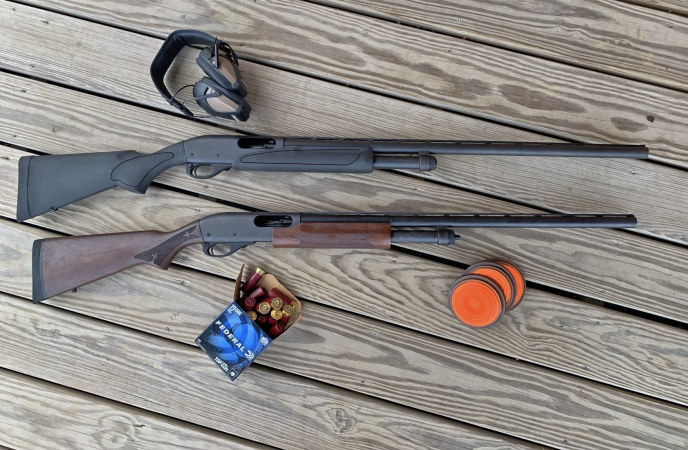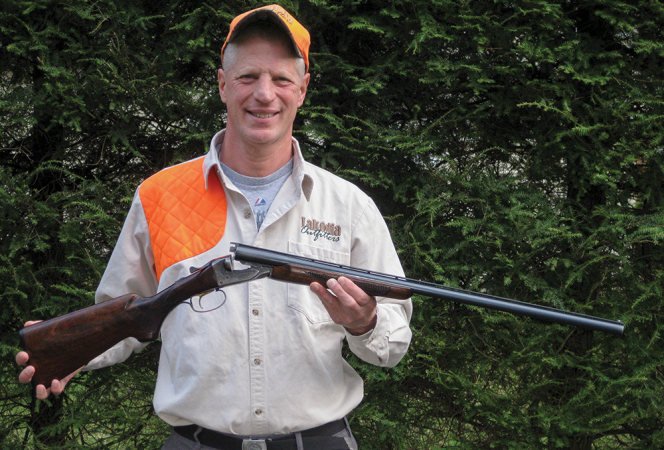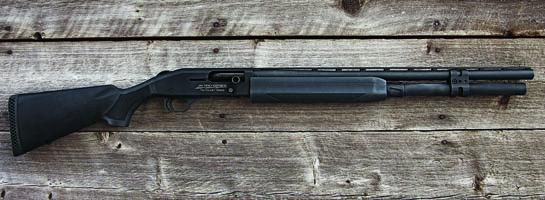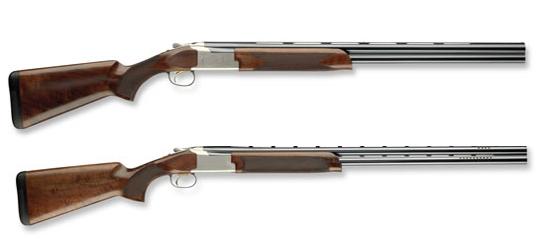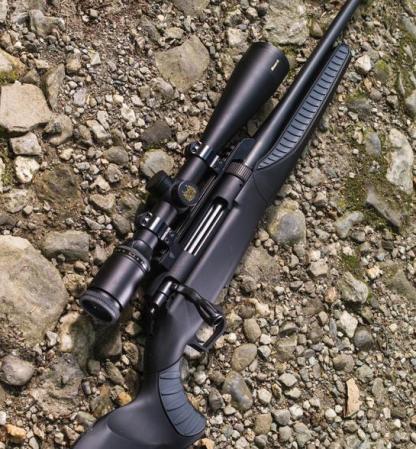We may earn revenue from the products available on this page and participate in affiliate programs. Learn More ›
RemArms, the company that bought the handgun, rifle, and shotgun side of Remington out of bankruptcy in the fall of 2020, has the most difficult task of all the manufacturers who purchased the various brands and products that once fell under the entire Big Green umbrella. The company will have to mass produce the most beloved (and most sold) pump-action shotgun in American history— the Remington 870 express—at the same high standard U.S. hunters have come to expect from a gun that has been in production for more than 70 years.
Remington factories shutdown under former ownership and did not produce guns during the bankruptcy. Finally, the “new” 870 Express hit store shelves this summer. I was able to snag one of the first models for testing, a black synthetic 12-gauge. I wanted to know how it stacked up against a battle-scared Magnum 870 Express that’s killed countless deer, ducks, and turkeys. So, I took both guns to the range to find out.
It was a closer duel than I anticipated. One of the things I’ve seen when pattern-testing modern shotguns is that newer guns often don’t throw shot as evenly as the old guard when shooting factory chokes. It’s not the case with every new shotgun I shoot, but it happens often enough when comparing an old model of a gun to the next generation that I’m no longer surprised when the new guns don’t shoot as well. And it’s not always a dramatic difference. Sometimes it’s just a few percentage points. But it’s a difference all the same.
Recently I talked to a gunsmith about this, who reported similar results in testing. He thinks this phenomenon is due to the fact that many manufacturers buy lower-quality steel for their chokes, which causes the guns to pattern poorly. He’s made chokes from foreign steel and U.S. steel, and learned that the U.S. steel always performs better. That doesn’t mean every new gun doesn’t pattern well; it’s just a trend both of us are seeing. And that’s a long explanation as to why I thought the new RemArms Express wouldn’t shoot as well as the old 870—which it didn’t. I did swap in the modified choke from the old 870 into the new one, and found it shot better.
But all told, the gap in performance between the two guns wasn’t as wide I as I thought it would be. And though this new 870 isn’t the gun your father or grandfather hunted with, it’s still a reliable workhorse that will only cost you $400 (I paid $433, which included the FFL transfer and state tax).
RemArm’s Remington 870 Express Specs
With more than 11 million guns sold, the 870 is the best pump-action of all-time, though the Mossberg 500 is nipping at its heels, thanks to the stall in production after Remington went into bankruptcy. In my opinion, RemArms’ 870 Express isn’t any different from the 870s Big Green produced. But I also haven’t hunted with an 870 that was made in the last decade, though I have seen and held them at gun shops. One thing I could tell right away is that the new gun is lighter than any 870 I have shot, and the matte finish is also slightly different. Here’s a look at the specification chart for the RemArms 870.
- Gauge: 12
- Chamber: 3-inch
- Barrel Length: 26 or 28 inches (tested)
- Length of Pull: 14 inches
- Trigger Pull Weight: 5.5 pounds
- Sights: Front bead
- Safety: Trigger-guard cross-bolt
- Finish: Matte black
- Overall Length: 46.5 or 48.5 inches
- Overall Weight: 7 pounds
- Mag Capacity: 4 rounds
- MSRP: $400
How Did the RemArms Remington 870 Express Function?

I had zero functional issues shooting the new 870, which is to be expected with a pump-action shotgun. Unless you wear out the firing pin or lifter, and as long as you can work the action, pumps typically run. RemArms still uses the twin-action slide bars found on the old Express and Wingmaster models. It’s a proven system that doesn’t often break. You really have to abuse the gun for decades in order for those bars to snap in half. Even then they are more likely to bend—I’ve never seen the bars actually break in two, though I have heard of it happening in rare cases.
The fore-end also slid backwards a bit with every shot, which helps open the action and eject the spent shotshell. It also makes returning the chamber forward and lifting the next round into battery a speedier transition. I think the reason the action came backward slightly was because I was shooting heavier 1¼-ounce Hevi-XII tungsten loads.
When I shot 1-ounce target loads on skeet, the fore-end did not slide backward at all, likely because lighter loads don’t produce as much recoil. The gun swung well for me on clay birds from all stations on the skeet field, and I managed to knock down a few doves with it at my parents farm. When you’re shooting birds, though, your focus is on the bird (as it should be). I wasn’t taking into account how the gun swings, if it fit me properly, and so on. Clays are a true test of a gun, because you can focus more on your shooting and how the gun handles.
I did notice the 870 was a little whippy due to its light weight. In other words, it’s quick and easy to swing, but that can also make it challenging to achieve consistent accuracy. Think about how easy it is to swing a light baseball bat; how fast it moves through strike zone versus a heavy bat and how much slower it is due to its weight. The 870 is the former. RemArms lists the guns’ total weight at 7.5 pounds, but when I put it on the scale at home, it came in at 7 pounds. The gun has more weight towards the rear of the gun, as opposed to the barrel, which can make connecting on clays tough for those who have trouble keeping the barrel moving through the target. If you don’t have that issue, it shouldn’t be a problem.
External Features of the RemArms Remington 870 Express
As I said before, I haven’t shot a new 870 Express in a decade. In fact, I don’t know how many “new” out-of-the-box 870s I have ever seen in the field. They are so durable that each one gets handed down from one generation to the next. That said, I like the exterior finish on the RemArms 870. It’s a standard matte black you will see on many price-point shotguns, but it has some added grip to it that I’ve never experienced with any other affordable shotgun. It just sticks in your hand better; it’s got some grit to it. Some matte finishes and blued-steel pumps are too slick, and it makes them hard to hold onto when you pull the trigger and all that force is sent right into your shoulder. Slick finishes also make it more difficult to work the fore-end, which is essential to shooting a pump.
The fore-end itself is slender, and there’s a channel carved out for your thumb and fingers on either side so you can get a better grip. This allows you to rapidly work the action when you need to get off multiple shots. The fore-end travel (the length the shooter will have to pump the fore-end to eject and load the next round) is right at 3 inches, which makes sense since this is a 3-inch gun. There are some pumps in the same chambering that have longer travel. The longer it takes a shooter to make that stroke, the slower the gun will operate.
One thing I do not like about the 870 is the bolt-release button. This applies to the old versions of the Express, too. It’s an obtrusive piece of metal that you have to push fairly hard to open the action. The button looks like a small claw and though it doesn’t hurt to push it in, it’s also not a pleasure, either. Browning’s BPS and the Winchester Model 12 have much more streamlined bolt releases that fit nicely against the trigger guard, and operate smoothly. The 870s sticks out like a sore thumb and leaves a dimpled imprint in your shooting finger if you’re a left-hander like me.
Is the New 870 as Good as the Old 870?

There’s nothing about the new 870 I can say I like more than the old version, but that doesn’t mean RemArms did a bad job with the Express. Most production shotgun makers will cut corners where they think most shooters won’t notice. They’re trying to make as much profit as they can, after all. And the Express is a budget gun, so there are going to be some exterior niceties that get left out, like a walnut fore-end in favor of a plastic one. But the guts of the gun are good.
To me, this is essentially the same model that rolled off the line right before Remington filed for bankruptcy and halted production. It was a close race between the new version and the old Magnum 870 Express I tested it against. The old gun is more well-built than the new one, but that was true even before RemArms started making 870s. Shooters had been complaining for years about the fall-off in quality of the Express.
One area where I did see a marked difference was on the patternboard. The old 870 shot better and more evenly than its counterpart, which you will see in the range results below. Also, the new 870 weighs 7 pounds unloaded, which makes recoil awful. The 1¼-ounce tungsten loads were far more manageable in the Magnum because it weighs a full pound more than the RemArms 870. Even the skeet loads were not enjoyable to shoot out of the RemArms gun. And I would not care to ever shoot a turkey load from the new 870 unless I was wearing a life jacket under my turkey vest.
The Remington 870 Express at the Pattern Board
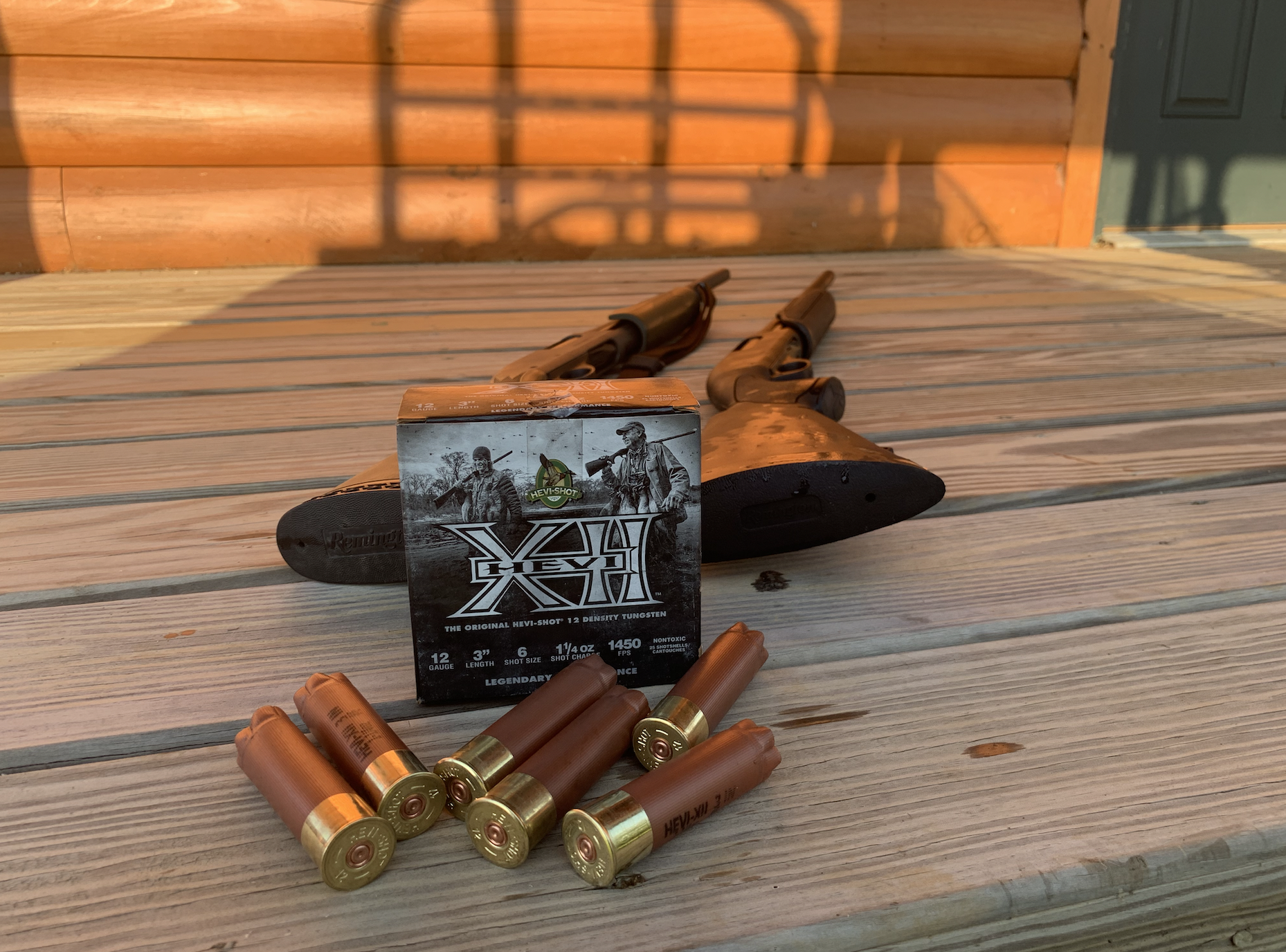
Remington’s original 870 patterned slightly better and more evenly inside a 30-inch circle at 35 yards than RemArms’ new 870. I shot each gun three times with Hevi-Shot’s 3-inch Hevi-XII No. 6s through a factory modified choke. And I took three more shots with each gun after swapping the old 870 choke into the new RemArms gun (and vice versa), which improved the pattern percentage of the new gun and slightly dropped it on the old one. The Hevi-XII tungsten shot runs out the muzzle at 1,450 fps and has a shot charge of 1¼ ounces with a shot density of 12.0 g/cc, 53.8 percent denser than steel.
The new 870 produced a three-shot average of 68 percent, which bumped up to 71 percent after I put the old 870 choke in. The Magnum 870 shot better at 76 percent, and then 71 percent with the RemArm’s choke. RemArms’ 870 shot 100 percent above the center of the target, with the exception of a few fliers below the center line, on all three shots. It was a 70/30 gun with the old choke in. Remington’s Magnum was much more even, a true 50/50 gun on the pattern board, and produced a 60/40 pattern with the RemArm’s choke. Here are the results from the range:
Shotshell: Hevi-XII 3-inch, No. 6 (1,450 fps, 1¼-ounce shot charge)
RemArms 870 Express
- Shot 1: 158/260 (61 percent)
- Shot 2: 171/260 (66 percent)
- Shot 3: 199/260 (77 percent)
RemArms 870 Express (with original 870 choke)
- Shot 1: 172/260 (66 percent)
- Shot 2: 181/260 (70 percent)
- Shot 3: 201/260 (77 percent)
Original Remington 870 Express Magnum
- Shot 1: 213/260 (82 percent)
- Shot 2: 185/260 (71 percent)
- Shot 3: 196/260 (75 percent)
Original Remington 870 Express Magnum (with new RemArm’s choke)
- Shot 1: 183/260 (70 percent)
- Shot 2: 201/260 (77 percent)
- Shot 3: 194/260 (75 percent)
Read Next: 5 Pump Shotguns That Could Replace the Remington 870
Is the RemArms 870 a Good Buy?
I think that because the 870 is so iconic, folks will continue to buy this gun. How many will be sold is up for debate. If my gun weighed more, I would be more confident in the success of the Express. And some of the new guns are heavier. I talked to Field & Stream shotguns editor Phil Bourjally, and his new 870 was 7.75 pounds, likely because it has a wood stock and fore-end. If the recoil is manageable, more folks will buy one. If not, I doubt as many will sell.
This gun is not a bad purchase, especially if you can find one for under $400. But also consider that 11 million 870s have rolled off the assembly line and you can certainly find a used Wingmaster (which is a better gun than a new Express as long as it’s functioning properly) for a similar price. Hell, even an old Express is a better buy because it weighs more and shoots a better pattern.
If you buy the new Express, you’re still getting a good value, and a reliable shotgun. You just have to decide if the price-point and functionality of the gun is right for you. Remember, the pump shotgun market is a competitively-priced one, and gun shops are typically flush with used and new inventory. Even now during a gun shortage, I still see affordable pumps on the shelves, so you have plenty of options. Now, it’s a matter of determining if the new 870 is the best choice for you.







